
Despite a recent surge in popularity of vinyl and record players, music streaming continues to be king. A wide variety of subscription-based music streaming services now grant access to millions of songs that you can access on any device you own. From Apple Music to Spotify and even Pandora, digital streaming platforms have democratized not only how people listen to music, but also how artists engage with fans.
Over the course of a month, we tested seven music streaming services to help you find the one that works best for you. Based on our testing, we found Tidal, Spotify and Apple Music to stand out the most.
Best music streaming service overall
Spotify is a great all-around music streaming service with an intuitive interface, slick social features and a large selection of music and podcasts.
Spotify is the most popular streaming platform in the world, with 350 million users and 150 million subscribers. The music streaming pioneer’s influence since its launch in 2011 has turned the music industry upside down — for better or worse — but after spending some time with the platform, it’s easy to see why Spotify has risen to the top.
First off, its ad-based free tier is the most attractive compared to other offerings. Individuals who can live with some sound quality limitations (the free tier is capped at 160 kbps) have access to over 80 million tracks and 4 million podcasts without paying a dime. The downside to the free tier is that you’ll have to listen to albums and singles on shuffle on the mobile phone app, and will miss out on offline listening.
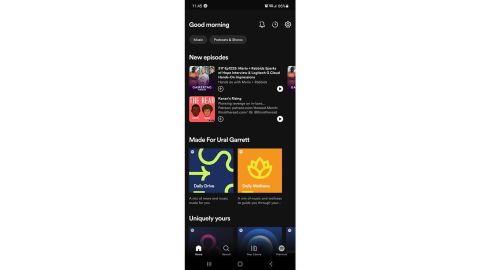
Curated playlists like Rap Caviar and Discover Weekly — as well as smart algorithm-based recommendations — make Spotify the premiere destination for music discovery. There are weekly, monthly and yearly playlists based around genres that users frequently listen to, which are a great way to discover new artists. That doesn’t even count various playlists curated internally by Spotify staff. Spotify is also compatible with Shazam, meaning you can use the latter app to identify a song on the radio or while your out at the mall and then be taken to the former to listen to it in full. Finding popular music or discovering new artists is simply the best with Spotify.
It’s also one of the few music services to also offer millions of podcasts within its app, and while this feature isn’t universally loved due to the controversial nature of some content, the ability to listen to NPR news segments between algorithmically curated music selections makes it a great alternative to radio. The service has a number of original and exclusive shows, including the polarizing-but-popular The Joe Rogan Experience, Stuff You Should Know, Living and Learning with Reba McEntire and Jemele Hill is Unbothered. Similar to music, discovering podcasts is easy, whether you’re searching by genre or hosts or just relying on Spotify’s algorithm.
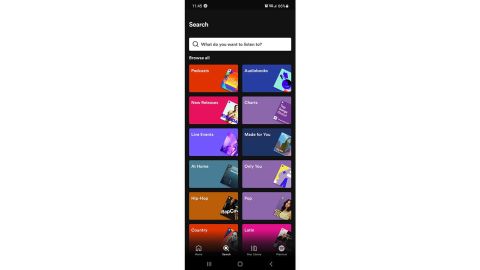
The one area where Spotify doesn’t really compete with rivals like Apple Music and Tidal is sound quality, offering only compressed streams — there is no lossless streaming here. Spotify Premium peaks at 320kps — akin to a very high quality mp3 file — which is good enough for the great majority of music listeners who aren’t concerned with hearing every little nuance. Audiophiles may be disappointed, but to our ears a track like Lizzo’s “About Damn Time” sounds as good as how one would hear on terrestrial or satellite radio. For the everyday listener, we think Spotify’s extensive discovery and social capabilities more than make up for that.
Spotify has some of the strongest social media features of any music service, allowing users to link their Facebook or Twitter accounts and see exactly what their friends are listening to. Users can also collaborate with friends on playlists or create a Blend playlist with friends that automatically pulls from both of your music tastes. You can send messages or playlists to a friend via direct messages, and access your favorite artists’ upcoming concerts and merch right from their Spotify page. Once the calendar year is nearly over, Spotify creates an amazing dissection of your music listening habits through Spotify Wrapped, which is always a popular share around social media.

One of the biggest problems that plague Spotify are the low artist payouts. At 0.0033, it takes 303,030 for an artist to make $1,000 which is way more needed than Apple Music and Tidal. It doesn’t help that Spotify pays record labels 52 percent of streaming revenue before giving between 15 – 50 percent to artists. Then there are controversial podcast including The Joe Rogan Experience and Off The Record with DJ Akademiks which some artists feel were given high paying exclusive deals on the backs of artists who simply don’t get paid very much.
Users who opt for the $9.99 Spotify Premium subscription have access to more music choices, ad-free listening, the ability to save music for offline listening and 320 kbps audio quality compared to the free tier’s max of 160kbps. Eventually, Spotify plans on competing with Tidal and Apple Music through a Spotify HiFi tier. There are also Duo ($12.99 for two people), Family ($15.99) and Student ($4.99) plans available as well.
Best music streaming service for audiophiles
We found Tidal to be the best music streaming platform for serious listeners due to top-tier audio quality and higher royalty payouts for music artists.
The best music streaming services not only keep listeners in mind but also consider artist fairness, and Tidal manages to do both. Beyond the base free plan that offers sound quality up to 160 kbps with limited ad interruptions, there are two monthly paid subscription tiers. Both offer access to music without ads and allow users to enjoy music while offline. There are also discounted family, military, student and first responder subscription plans available.
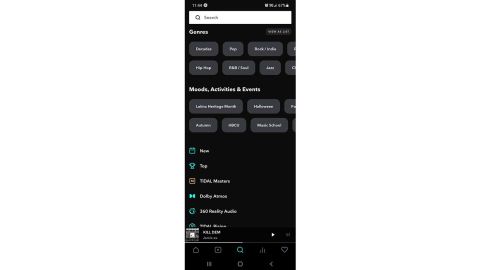
Starting with the HiFi plan at $9.99 a month, can access more than 90 million song selections at CD-quality, alongside 450,000 pieces of video content including music videos, artist-focused features and movies. The improved audio quality is definitely noticeable compared to Spotify and other streaming services that don’t offer lossless audio. Additionally, Tidal frequently features some really cool live streaming content including concerts and music festivals like Hot 97 Summer Jam and Made in America.
Serious music fans and audiophiles alike are going to appreciate the $19.99 HiFi Plus plan which features various better-than-CD-quality (16 bit/44.1 kHz)audio formats, including both high-resolution formats like MQA (“Master Quality Authenticated”; available in 24bit/96 khZ and 24 bit/192kHz quality) and surround options such as Dolby Atmos and Sony 360 Reality Audio).
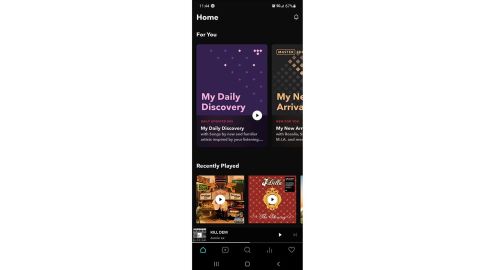
Tidal already has earned a reputation for paying artists more per stream than many other competing services, and the service increases that amount through its HiFi Plus plan. 10% of your subscription cost goes directly to the artists you listen to the most. Also, you get a shareable monthly summary to let your social followers know exactly who those artists are..
Audio quality on Tidal’s free tier is comparable to Spotify. On the HiFi Plus plan, listening to We checked out a CD-quality lossless stream of “About Damn Time” and indeed we heardCD-quality richness without any audible compression artifacts or fuzziness. You also get access to better-than-CD-quality MQA tracks,(though these are only accessible at the highest possible fidelity if you have an MQA-compatible DAC or receiver, and are best enjoyed if you also have a high-fidelity set of headphones or speakers). Tidal maintains its audiophile cred in hosting some ultra-high-resolution content from specialist audiophile labels like 2L at 24 bit / 352kHz, beyond what Apple Music currently offers but likely of interest mostly to serious enthusiasts.
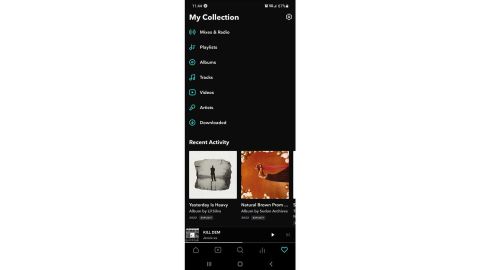
Available via web browser, desktop app, iOS and Android, Tidal offers an intuitive user experience across all devices. Just be mindful that you can’t listen to Master quality through a web browser. Accessing music selections, curated playlists and videos is fairly simple, as is casting to streaming devices like a Chromecast or set of Sonos speakers. Moreso, the curated playlists do a good job of anticipating what users may possibly be into after listening to a single track. That’s in addition to monthly playlists curated towards your personal taste.
Best music streaming service for Apple users
Apple Music is perfect for individuals who are already entrenched in Apple’s hardware and software ecosystem — though it works great on other devices too.
Apple changed the music industry forever in 2001 with iTunes, which has since evolved into a traditional music streaming service in the form of Apple Music.
There are two subscription options available, starting with the $4.99 Apple Music Voice plan that works exclusively through Siri-enabled devices like iPhones and HomePods. For a more standard music streaming experience, there’s an Individual $9.99 plan alongside student and family plans. Apple Music is also part of the Apple One bundle (which starts at $14.95 per month and also includes Apple Arcade, Apple TV+, Apple News+ and Apple Fitness+), making it a great value for those who use all of Apple’s various services. Users have access to over 90 million songs with full playback controls and unlimited song skipping.
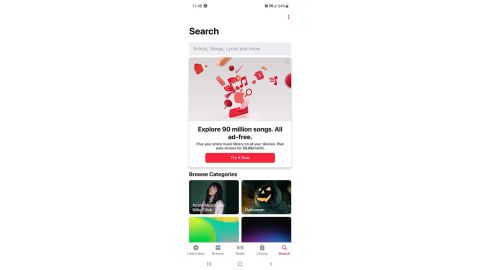
The Individual plan also comes with Spatial Audio with Dolby Atmos for 360-degree listening, alongside Lossless Audio and Apple Digital Masters of select albums for music quality that even rivals Tidal. Though the experience is made for users with Apple devices, Android users won’t have any trouble using Apple Music. The streaming app’s Android version even has a few exclusive features, including crossfading between tracks and gapless playback. Outside of that, features like Spatial Audio will work on Android devices that have Dolby Atmos.

Related: Apple Music vs. Spotify: Which is right for you?
Apple Music allows users to store their own library of music, which is great for those who either want to keep their old iTunes catalog or collection of MP3s. This is definitely useful for those who have music that isn’t available on any music subscription service. — And users who want the option to support their favorite artists by buying songs and albums outright can do so from within the Music app, via an opt-in link to the iTunes Store.
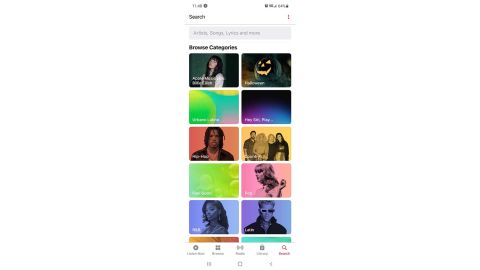
Apple Music offers tracks in lossless, high-resolution, and Dolby Atmos as well as its proprietary Spatial Audio format, along with compressed audio streaming, so audio quality is on par with Tidal. It doesn’t have as many audiophile-leaning high fidelity tracks as Tidal does, though it’s not too far behind. “About Damn Time” streaming losslessly sounds just as good on Apple Music as it does on Tidal considering most major label releases usually get lossless or high-resolution releases.
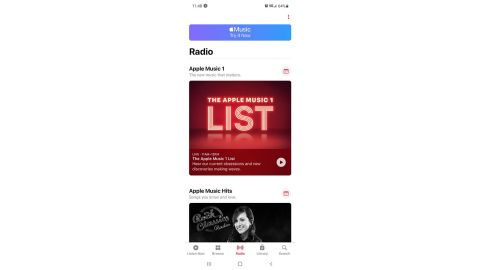
Apple Music offers a wide variety of curated playlists and “radio” stations. One of the service’s biggest attractions is Apple Music 1, which is a global radio station featuring some of the world’s biggest DJs and tastemakers. Music lovers with a taste for everything the world of music has to offer are going to have a blast with this show. Apple Music 1 even extends to artists-controlled radio stations like Nicki Minaj’s Queen Radio or blonded Radio from Frank Ocean.
| Library Size |
Over 82 million |
Over 90 million |
Over 90 million |
Over 60 million |
Over 30 million |
|---|---|---|---|---|---|
| Supported Audio Formats |
AAC, Ogg Vorbis |
AAC, ALAC, FLAC, MQA, |
AAC, AALC, |
AAC |
AAC |
| Highest bitrate |
320 kbps |
4,608 kbps |
256 kbps |
256 kbps |
192 kbps |
| Artist<br />Payout Per Stream |
$0.00348 |
$0.00876 |
$0.00675 |
$0.01009 |
$0.00203 |
| Monthly subscription price |
Spotify Premium – $9.99 |
Hi-Fi: $9.99 |
Apple Music $9.99 |
YouTube Music Subscription $9.99 |
Pandora Plus $4.99 |
| Price |
$9.99 |
$9.99 |
$9.99 |
$9.99 |
$4.99 |
If you’re on an extra tight budget, you can always start with a service that offers a free tier, like Spotify or Pandora. One thing that’s consistent among free tiers of music streaming services is that many will have reduced song choices, heavy ads between tracks, a limited amount of skips between songs and a lack of offline play. Then there are more meaningful differences — Spotify’s wide selection may be great for users who want a balance of music and podcasts, while Pandora’s radio-style play may be best for those who just need background music during work or morning jog.
Those looking to save money should also consider that they may already have a music streaming service connected to one of their existing subscriptions. Amazon Prime subscribers get instant access to Amazon Music, though its track selection is slim compared to the higher-end Amazon Music Unlimited plan. The same goes for YouTube Premium subscribers, who automatically get YouTube Music for free.
Apple device users have the option of getting Apple Music’s $4.99 Voice plan, which is the cheapest of any service we tested but reduces the user experience to voice-based Siri controls. Those same users who want more functionality can always upgrade to the Individual $9.99 plan, which is the standard tier price amongst rival services like Spotify, Tidal, Amazon Music Unlimited ($8.99 for Prime subscribers), YouTube Music, Deezer Premium and the like. Pandora also has a $4.99 Pandora Plus plan which allows unlimited song skips while the $9.99 premium plan allows users to create and share playlists.
Audiophiles who want higher quality audio when listening to music are going to have to pay more. Tidal’s HiFi Plus, which gives you access to ultra-high-resolution 24bit/192kHz releases in the Master Quality Audio (MQA) format, costs $19.99 a month.
All of the services we listened to for this review offer compressed audio streams (meaning some data is removed to save bandwidth, as in MP3 audio files) at their basic free tiers. This “lossy” compressed audio is what created the digital music revolution in the first place, with the emergence of the MP3 and AAC file formats, and most of what you find offered in free streaming is offered at this quality. At this level, Spotify and Tidal both provide the best sound streaming quality at around 160kbps — acceptable for the great majority of listeners. Pandora only offers 64kbps streaming — the audio quality of most podcast streams — at its free tier, while YouTube Music only goes up to 128kbps without a subscription.
These compressed formats are acceptable for most listeners, and most people are even hard pressed to tell compressed audio from “lossless” or CD-quality tracks. There’s some research indicating that listeners may miss out on some of the content of music at lower bit rates, but the jury has been out for years and the question is unlikely to be settled anytime soon.
Audiophiles and other serious music listeners do demand CD-quality or higher, however, and many of the streaming services are now competing on that front. When comparing the paid services at $9.99 and up, audio quality and the number of higher-resolution formats offered varies a bit between services.
Apple Music has the most robust audio format offerings for its standard Individual subscription tier. This includes both Apple Music Lossless (up to 24-bit/48kHz) and Hi-Res Lossless (up to 24-bit/192kHz) in addition to Apple’s own Spatial Audio (which works with the head-tracking feature in AirPods headphones) with Dolby Atmos. Amazon Music Unlimited has an impressive range between 16 bit/44.1kHz, 24bit and up to 192kHz in addition to Dolby Atmos and Sony’s 360 Reality Audio.
While it was the early leader in high-resolution streaming, Tidal offers similar audio quality to Apple Music for its paid subscribers, but has a somewhat larger library, with up to 80 million tracks available in CD-or-better resolution. For the standard HiFi subscription, users get CD-quality lossless streaming (1411kbps or 16-bit / 44.1kHz), or they can choose a 320kbps “High” quality compressed setting for slower connection speeds. Alongside formats like Dolby Atmos Music and Sony 360 Audio, the $19.99 HiFi Plus setting also grants users access to “Master” quality MQA tracks, which you can listen to without additional hardware at 24bit/96kHz quality, or up to 24bit/192 kHz with a fully MQA-capable DAC/headphone amp like iFi’s affordable Go Bar. Tidal maintains its audiophile cred in hosting some ultra-high-resolution content from specialist audiophile labels like 2L at 24 bit / 352kHz
Spotify is the outlier here, only providing compressed audio even for paid subscribers (there isn’t a high-fidelity option for the service yet, though it’s in the works). That said, it provides 320kps quality streaming, which for most listeners is nearly indistinguishable from lossless (there are several listening tests available online if you’d like to challenge your own listening skills).
When you’re looking for your favorite tracks or creating a playlist, the process should be simple and efficient regardless of whether you’re using a web browser, desktop or mobile apps.
Spotify has the best user interface of any music streaming service all around. Controlling music through the media controls on the bottom, watching friends’ music choices on the right, having access to playlists on the left and notifications on the top goes a long way in keeping everything manageable. The synergy between web browser, desktop and mobile apps are fantastic as music stopped on one device can be continued on another exactly where one left off.
Between streaming music, playing music from the library cloud and Apple Music 1 radio, Apple Music is definitely the most complicated to use on desktop and web. The mobile app for Apple Music is simpler on mobile devices, and in line with Tidal, Amazon Music Unlimited and Deezer.
For sheer simplicity purposes, Pandora’s more radio-leaning interface makes it the easiest to use from jump since the experience leans toward music discovery. YouTube Music has a decent mobile app, though it can only be used on desktop via a web browser.
Music and podcast library
Music streaming services live and die by their catalog. A large amount of the most popular subscription services at their standard tiers have all the top 40 offerings, though things get a bit tricky for free tiers, indies and older artists libraries. Apple Music, Deezer and Tidal have over 90 million tracks which makes them best for general music lovers with a wider range of taste.
Spotify has more than 80 million song selections, though it’s notably lacking such and legendary artists as Joni Mitchell, Neil Young and India Arie. What it makes up for in its lower catalog number is a huge amount of podcasts, making it the biggest compared to other music streaming services. That music choice number also gets windled down for its free tier.
On the lower end of the spectrum is Amazon Music Unlimited at 60 million (with around 2 million available for the free tier through Amazon Prime) and YouTube Music at about 50 million (though that number is significantly higher with its YouTube integration).
Some services like Apple Music, Tidal and YouTube Music let you watch video content like music videos or live streams of concerts. Spotify’s social features are unrivaled. Users who can’t let go of their MP3s from 2005 can upload music directly to Apple Music, YouTube Music and Deezer for cloud streaming.
For music lovers who want a serious look into global music culture, Apple Music 1 radio is an experience you won’t get on any other music streaming service. That doesn’t even count the artist-curated radio stations.
However, the most important feature is how these services handle playlisting.
When it comes to offering algorithmic personalized playlists based on your music tastes, Apple Music, Tidal, Spotify and Pandora are great options. Many of these services have monthly playlists that introduce users to newer artists based on what they listen to. Then there are the internally curated playlists, including Spotify’s highly influential Rap Caviar. Apple Music, Tidal and Spotify also have dozens of artist-backed playlists. If you ever want to have an idea of what Jay Z or Beyoncé is listening to, Tidal is it.
Available for $9.99 per month — which also gets you YouTube Premium for ad-free video viewing — YouTube Music makes sense for users who are deep in Google’s ecosystem or simply spend a lot of time on YouTube. You can upload your own music to the cloud for streaming, and since it’s integrated with YouTube, you can watch music videos and listen to tracks that are outside of the service’s official selection. Be mindful that there isn’t a desktop app (it only works within a web browser on PCs) and that YouTube Music only offers compressed audio streams — there are no lossless or high-resolution options.
By default, being an Amazon Prime member gives subscribers access to over 2 million tracks from Amazon Music, which also includes Alexa integration for hands-free listening via your Echo device. Starting at $8.99 for Prime members, Amazon Music Unlimited opens you up to more music and higher-quality audio, with lossless and high-resolution tracks available. While audio quality is on par now with Apple and Tidal, compared to other services, there isn’t very much to do outside of listening to music, and the X-Ray feature (which aims to provide extra information on artists) is as inconsistent as its Amazon Prime Video counterpart. Also, Prime members only save a mere dollar on the service compared to non-Prime users.
Pandora
From $4.99 at Pandora
Music listeners who’d rather let algorithms take over their experience should try Pandora, which has a free option and offers radio-style playback that’s a great way to discover new music and artists. If you want to hit that skip button with no limits — and without ads — you can step up to the $4.99 Plus or $9.99 Premium plans. Because Pandora is more like radio, it may be less ideal for people who want to control what they listen to. Pandora also only offers compressed audio streaming, with no options for CD-quality lossless or high-resolution formats.
Technically the oldest traditional music streaming service — it first launched in France around 2007 — Deezer is a unique offering with some cool features. Besides having a catalog that rivals Apple Music and Tidal, Deezer lets users upload their own mp3s to the cloud. Deezer sets itself apart from other streaming services by having a large amount of selected FM radio stations available. Then again, many users turn to music streaming services as an alternative to traditional terrestrial radio so that may not matter much. The standard tier costs $10.99 and includes the ability to listen to high-fidelity audio. Though that’s cheaper than Tidal’s higher fidelity plan, it currently only offers CD-quality lossless streams, and doesn’t provide ultra-high-resolution 24bit/96kHz or 192kHz tracks like Apple and Tidal.
